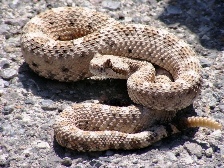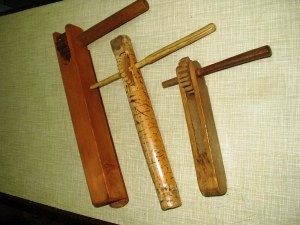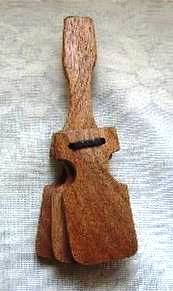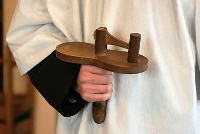
Our priest and I have recently come into a point of contention. While preparing for the Triduum liturgies, he has denied the use of the crotalus on Maundy Thursday, citing that the General Instruction no longer calls for its use.
As you know, in the Gospel of Mark 16 we read about the handling of snakes. The crotalus is a particularly festive snake, for it has a great rattle (Latin crotalum, a “rattle” or a kind of castanet). Yet… when picking it up and shaking it repeatedly it can become a little testy. This makes for a somewhat agitated liturgy and a steady decline in the number of altar boys.
 When handling the crotalus, I suggest brushing up also on the use of liturgical beretta.
When handling the crotalus, I suggest brushing up also on the use of liturgical beretta.
An alternative to the crotalus is the… crotalus, a hand-held gadget which has a ratchet within. In Italian it can be known onomotpoetically as a raganella. When rotated it makes a loud ratcheting sound. These are a sound alternative to sometimes less cooperative snake.
 Another instrument for this purpose is a thingie with a little wooden hammer which bangs on a piece of wood mounted on a handle. Italians call it a “tric troc”. What that one is called in Latin, I cannot tell.
Another instrument for this purpose is a thingie with a little wooden hammer which bangs on a piece of wood mounted on a handle. Italians call it a “tric troc”. What that one is called in Latin, I cannot tell.
For Holy Week, the last time bells, or organ, can be rung in the Roman Rite is for the first few words of the Gloria of Holy Thursday. After the beginning of the Gloria there should be no 
That said, it is a strong and venerable custom that noise-maker such as the crotulus or the “tric troc”, clappers, should be used.
I cannot imagine not using some noise-maker if one is available. The associations of the sounds with the Triduum are deeply part of the way we Catholics do things. They set a wholly different tone during the Triduum.
It seems to me that they should always be used, whether the GIRM mentions them or not. They are not mentioned in the rubrics of the Extraordinary Form either but.. there they are! For centuries used widely in many cultures. Furthermore, this would be a good and easily example of how you might foster that “mutual enrichment” desired by the Holy Father.
And there is always the liturgical beretta.


































“And there is always the liturgical beretta.”
Nice.
We use those clappers in our conservative N.O. parish (still using the altar rail, altar boys only, etc). Very cool. Most folks don’t even know what they are. The first time I heard them I was sorta startled.
Crotola est illud ligneum instrumentum quo in tribus diebus majoris hebdomadae cum non pulsantur campanae utimur in ecclesia http://bit.ly/f5wCeU
Crepitaculum: http://bit.ly/i7r1Zj
The clappers are used in the trad parish in Sacramento, CA, also.
The “tric troc” clappers are used at our parish during processions of the Blessed Sacrament. I agree, very cool.
When I was an assoc. Pastor, I introduced the clapper during the procession of Blessed Sacrament to the altar of reposition, at first the Pastor was not keen of the idea but he did not forbid me then the following year we use it again w/o his hesitation and it became a fixture every year. Now that I am a Pastor, it is one of the staple instrument during Holy Week.
I need to make sure Father has one of these . . . It’s in the category of things I remember having heard once, and then didn’t hear again for a sufficiently long time to wonder if I had just made up the memory of hearing them before. I’m glad I didn’t.
To not have a noise maker seems unfair to those who are blind or with poor vision.
As an altar boy, very many years ago, we always used the clappers.
In Brazil we use a “matraca“:
At my parish, the venerable custom of using the clappers on Holy Thursday survived until two years ago, when a new pastor finally banished them, together with other venerable customs. Once gone, they will likely never be returned to use.
Ah yes, that which is not forbidden is compulsory — and vice versa. Come to think of it, that explains much of the liturgical nonsense nowadays.
Wish I’d seen/heard these at some point in my life, but as far as I recall I haven’t, alas.
Here is an illustration of a rattle, which the text says was originally for liturgical use.
A few years back, I took a video at SFdS Oratory where a tric troc (I guess) was used.
However, when using the liturgical beretta in conjunction with the crotalus it would be wise to employ the extraordinary form projectile (center fire shotshell) in lieu of the ordinary fmj.
What does the rubrics say about the liturgical osculi in conjunction with the use of the beretta? Has the deacon to kiss the hand of the presbyter and then the empty ammo magazine when he receives it, and giving a full magazine kissing the magazine and then the receiving hand of the presbyter? Are these osculi suspended when the others are (iirc lenten time or passion time)?
Who is suitable for the purification of the beretta after use?
In my parish is a clapper in use shown in the hand of a altar boy.
I can remember them being used when I was an alter boy in the late 50’s early 60’s
The use of bells is but a vague memory to me; the parish I grew up in (St. James in Omaha) had abandoned them by the time we moved there. Occasionally I’d go with my cousins to St. Richard’s, where they had bells for a long time. But the last time I remember hearing them was at an Easter Mass in Truth or Consequences, NM in 1990. I have no memory of the clapper or the rattle.
BTW, Father, when using the liturgical beretta, the slogan should be “Say the Black, Do the Red, Aim for the Chest”. (I was going to say, “Aim for the Center of Mass”, but ….)
In my Czech hometown altar boys use these clappers also in Angelus time. Normally the church bells would ring for Angelus 6 a.m., 12, 6 p.m., but as the bells are silent during the Triduum, altar boys go through the town and make noise with clappers.
The same custom as Jana has described exists in parts of germany. There is a saying “Vor Ostern fliegen die Glocken nach Rom” = “the bells are flying to rome before easter” and therefor the angelus-ringing has to be replace by other noise-making-instruments. This may be rattles or clappers or both of them., opperated by altar-servers or just any other children.
In the little town of Linz am Rhein (about 2 miles south of the former bridge of Remagen) there are 200 to 300 men and children running the streets on good friday and holy saturday three times a day. You can see pictures of this event at http://www.linz.de/html2005/deutsch/veranstalt/vs-2.php and http://www.general-anzeiger-bonn.de/index.php?k=loka&itemid=10001&detailid=579723.
p.s.: In all the catholic churches in this region of germany I have ever been to, there are clappers in use for the liturgies on maundy thursday and good friday.
In case you want to use one someone has got rid of it in the past: here you canfind an instruction how to build a rattle (in german) http://www.minis-dhz.de/index.php?site=stuff
They’ve kept the clappers for Holy Thursday in my parish in Ireland. The church is big, stone-built, and as the Mass starts at 7:30 pm it’s usually quite dusky by the time of the elevations, so the sound of the clapper echoing in that large darkening space (they don’t overdo it with the electric lights) really contributes a sense of austere solemnity.
I just wish they’d kept the veils for the images as well – those haven’t been seen since about the mid-80s.
Are the clappers required to keep time with on eagles wings :>)
Just askin
The sacristy of the parish I belong to owns two of the hammer-on-a-peanut style clappers, but they aren’t used; they’re stored in a closet with the “fancy” thurible that’s only used at Christmas and Easter.
Normally, I am all for the use of just about any “old-school” liturgical accessory available…but I don’t know that I actually lament the retirement of this particular gadget. I don’t think the sound is edifying or haunting so much as it is annoying and jarring. In my opinion, silence works better.
Aren’t the ‘clappers and rattlers’ used in cloistered monasteries as a ‘wake-up call’?
‘And there is always the liturgical beretta’-nice one, Father Z! ; )
As an alternative to Mr. Crotalus (who can indeed be a testy character and a fast mover too, so difficult to hit with the small liturgical Beretta), may I suggest his distant cousin Coluber constrictor, the Black Racer?
He has devised the very clever tactic of mimicking Mr. Crotalus by vibrating the specially designed tip of his tail in dry leaves. But he doesn’t bite (or at least very rarely). We had one in our yard for years, keeping down the chipmunks and nodding politely to us as he went on his rounds, until he died of apparent old age. The first time I encountered him he startled me very much with his “rattle” – even though I was looking right at him my heart skipped a beat.
The altar boy will need to carry a liturgically appropriate container for the dry leaves . . . . but there are always plenty of those around. Maybe save some palms?
We use the clapper at my N.O. parish…but we also use the bells at every Mass. Yes-Altar boys and girls, no- altar rail, but yes, patens at Holy Communion.
We used the clappers when I was young. I always thought and was convinced that the sound recalled the pounding of the nails into the hands and feet of Christ at the Elevation. Someone must have told me that then, I have never forgotten it.
As a child of Vatican II, I have no memory of these things. They were likely banished with our knee-jerk wreckovation in the 60’s. I do however remember my father and brothers talking about using clappers in the 30’s and 50’s.
That having been said – Last year I was at an internation soccer match with 70,000 screaming, vuvuzula blowing fans. In the midst of this chaos, a quarter the way around the stadium from me, a small elderly gentleman wearing the colors of his Mexico team stood up and raised a VERY large ratchet-style crotalus above his head. It took both his hands and all his strength to get it spinning and when he did it drowned out EVERYTHING! I wonder where he got the idea ;-)
Yes – the clappers! How often I spoke of them to our children, trying to explain just what they were and why they were used. This post and comments have brought back fond memories and also re-ignited the sorrow I feel over the loss of many meaningful Catholic traditions and treasures. I am saddened to report most people in the parish I now belong to, would say a clapper is the person who applauds when the contemporary choir finishes their performance.
irishgirl,
Yes, talantons are used in Eastern Catholic & Orthodox monasteries to call the monks (or nuns) to prayer. Our Eastern Catholic parish also uses the clapper during the outside procession on Holy Thursday where the priest processes around the Church grounds with the plaschinitza (cloth with the image of the Body of Christ, similar to the Shroud).
Here in the Austrian Tirol, we do not use clappers; rather we have many forms of devices called ‘Karfreitagsratscher’ (Good Friday ratchets) whose designs date back more than 500 years (perhaps even further). One large very old Karfreitagsratsche at our village Pinswang’s St. Ulrichskirche has wooden mallet heads attached to the fixed wooden slats. Thus, instead of creating a slapping sound, the mallet heads slam hard against one side of the hollow wooden box to which they are affixed, thereby creating a remarkably loud banging noise. When cranked at speed, the violent percussive sound can be quite startling; you can hear it throughout our village. You can see a photo of it at: http://ausserferner.wordpress.com/2010/04/01/karfreitag/
The crotalus which TMKent observed is still known in the UK as a ‘football rattle’ and was a common sight at matches until the 1960s. I suspect most Catholic parishes acquired theirs at a sports emporium.
Andreas:
Our Pastor rigged one of those up two years ago. He loves to do German stuff for all the German speakers buried in our cemetery. The first time I heard it, it sounded like someone hurling large books around the sacristy.
A little bit of the old country right here in SE Indiana.
Andreas,
That is COMPLETELY awesome! Looks like something my father might have built on a dare (he was a Combat Engineer and their pride is that they can build anything out of nothing).
There are some old croquet mallets in the garage . . . . hmmmm . . . . .